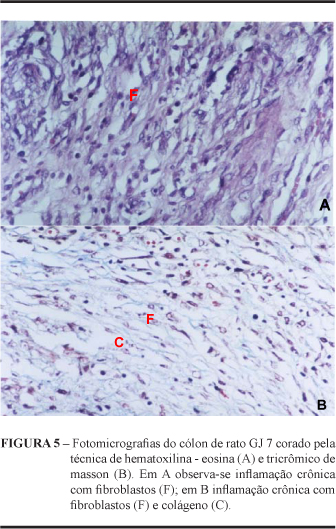INTRODUCTION: Phytotherapy has been drawing interest from the scientific community regarding its potential wound healing properties. There are few studies available that present a correct scientific methodology and, therefore, phytotherapy remains an open field for further research. PURPOSE: To evaluate the effects of Jatropha gossypiifolia L. (bellyache bush) on the healing of colonic anastomosis in rats. METHODS: Forty Wistar rats were subjected to a complete section of the colon, that was soon sutured with eight separate stitches using monofilament polipropilene 6-0. Randomly, the animals were divided into control group (CG), with 20 rats, which were injected with 0.9% sodium chloride solution intraperitoneally (1mL/kg) and Jatropha group (JG), also with 20 rats, which were injected with Jatropha gossypiifolia L. alcoholic extract intraperitoneally (1mL/kg). Each of the groups was subdivided into two subgroups of ten rats, according to the sacrifice date, third and seventh days (CG3/ CG7 and JG3/ JG7). After sacrifice, the segment of the colon containing 1cm proximal and distal to the site of anastomosis was removed and subjected to the pressure test with air insuflation. This segment was then opened and a 1.0 x 0.5cm part was removed and placed under 10% formaldehyde for histological analysis with hematoxylin-eosin and Masson's trichrome stainings. RESULTS: The evaluation of the pressure rupture test demonstrated statistical significance regarding the sacrifice date. On the third day, the average pressure of the CG (25,4mmHg) and the JG (76,4mHg) revealed p = 0.013, and on the seventh day, the average pressure of the CG (187,3 mmHg.) and the JG (135,1 mmHg.) revealed p = 0.014. When assessing the microscopic variables among the groups of the 3rd day, only the variables edema and polymorphonuclear cells did not show statistical differences. On the 7th day, all of the variables assessed demonstrated significant differences. CONCLUSIONS: Regarding mechanical resistance, there was a difference in resistance between the JG3 and the CG3, and a shift of resistance when comparing the JG7 and CG7, which suggests a weakening of the Jatropha effect at a later stage of healing. The histological evaluation revealed an improvement of the acute inflammatory process in the JG3 when compared to the CG3, which was even more intense during the chronic stage, when the two groups are compared on the seventh day. The histological study of the inflammatory process, in general, showed a favorable effect to the Jatropha group compared to the control group.
Wound Healing; Plants, Medicinal; Jatropha gossypiifolia L.; Anastomosis; Rats








